Statement of the Problem
Modern scientists focus on the problem of the climate change because of expecting the dramatic consequences in the future.
The problem is that the climate is changing, while affecting the environment and shaping the people’s lives through increasing the air and surface temperatures.
The main cause of the drastic changes is the global warming.
It is necessary to concentrate on solving the climate change problem using the interdisciplinary approach and referring to the accomplishments in the fields of industrial ecology and environmental chemistry.
Modern scientists focus on the problem of the climate change because of expecting the dramatic consequences of the process in the future. The worst scenarios of developing the climate change process can lead to the significant environmental change, the impact of which is difficult to be predicted completely. However, the problem is in the fact that the climate is changing, while affecting the environment and shaping the people’s lives through increasing the air and surface temperatures, and the main cause of the drastic changes is the global warming. While focusing on global warming as the major cause of the climate change, it is necessary to concentrate on solving the climate change problem using the interdisciplinary approach and referring to the accomplishments in the fields of industrial ecology and environmental chemistry.
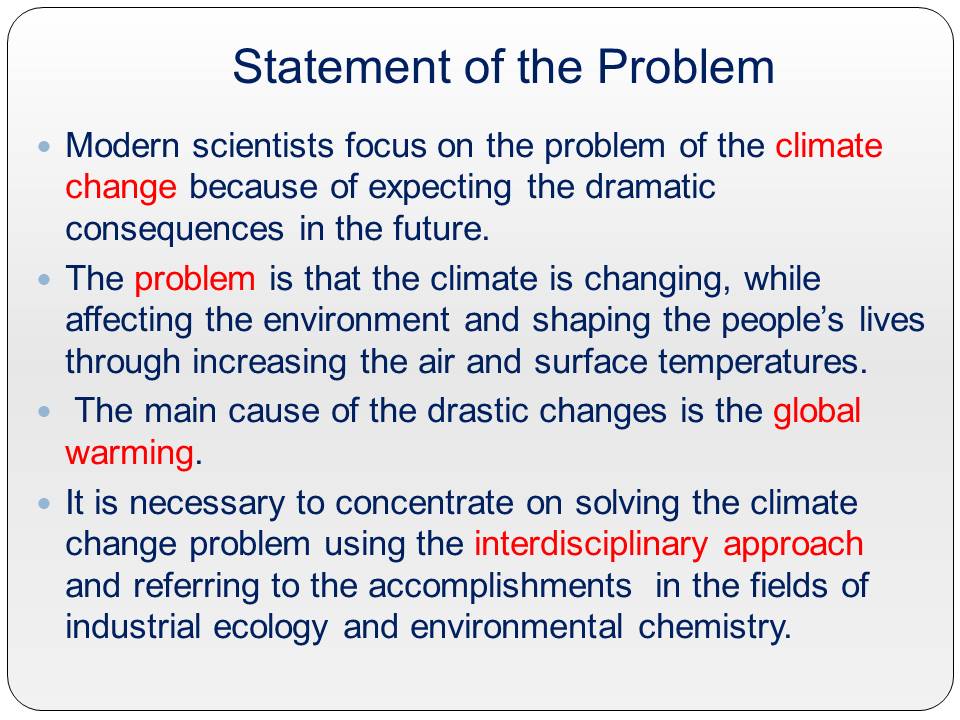
Historical Perspective and Scientists’ Approach
1980s – the problem of climate change received the media attention in connection with increasing average temperatures, discussions of greenhouse effect, and global warming.
During a long period of time, scientists partially discussed the problem, focusing on the carbon dioxide increase in the air and global warming(Dessler, 2011, p. 24).
1990s – changes in approaching the problem and analyzing the data on the global temperature increase.
Some scientists discuss the climate change problem as illusory.
Potential benefits: the change of climates into mild and more comfortable for people (Lean, 2010, p. 111).
Many scientists agree that the problem is important (McNall, 2011, p. 34).
The problem of climate change was not discussed actively until the 1980s, when the problem received the media attention in connection with the anomaly of increasing average temperatures, discussions of greenhouse effect, and global warming. Although the problem is recent, its potential impact on the environment is dramatic.
During a long period of time, scientists did not accentuate the existence of the problem, partially discussing it while focusing on the carbon dioxide increase in the air, greenhouse effect, and global warming (Dessler, 2011, p. 24). The situation changed in the 1990s because of analyzing the data on the global temperature increase. Referring to the changes in the Northern and the Southern hemispheres, the scientists noted the significant alternations associated with the climate’s stability.
Different scientists discuss the climate change problem as illusory because the effect of the change can be observed only in thousands of years. Moreover, there are the potential benefits such as the change of climates into mild and more comfortable for people (Lean, 2010, p. 111).
However, many scientists agree that the problem is important, and it should be addressed and solved appropriately (McNall, 2011, p. 34).
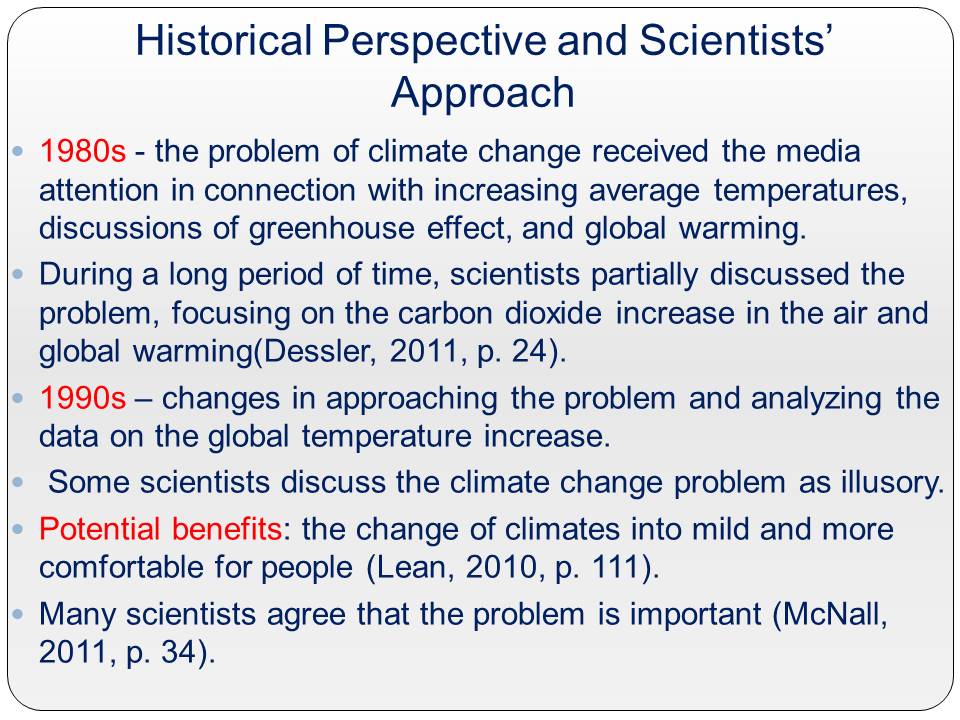
Climate Change: Causes and Aspects
Global warming is the main cause of the climate change.
Global warming is the result of increasing the concentration of carbon dioxide in the atmosphere.
Increases in the carbon dioxide concentration are the consequences of anthropogenic activities, such as the development of industries, mining, and transportation.
Global warming leads to warming the oceans, melting glaciers, sea level risings, changes in the climate, when some territories become wetter, and the other regions become dryer (NASA: Global climate change, 2014).
The main cause of the climate change is the global warming which is the result of increasing the concentration of carbon dioxide in the atmosphere. The increases of the carbon dioxide concentration affected by the impact of the solar energy lead to the greenhouse effect. Thus, increases of the carbon dioxide concentration are the consequences of anthropogenic activities, such as the development of industries, mining, and transportation. The men’s activities lead to the situation when the greenhouse gases are absorbed in the atmosphere to heat the surface of the Earth, and the sunlight passes to the surface more actively, increasing the radiation levels.
As a result, global warming leads to warming the oceans, melting glaciers, sea level risings, changes in the climate, when some territories become wetter, and the other regions become dryer (NASA: Global climate change, 2014).
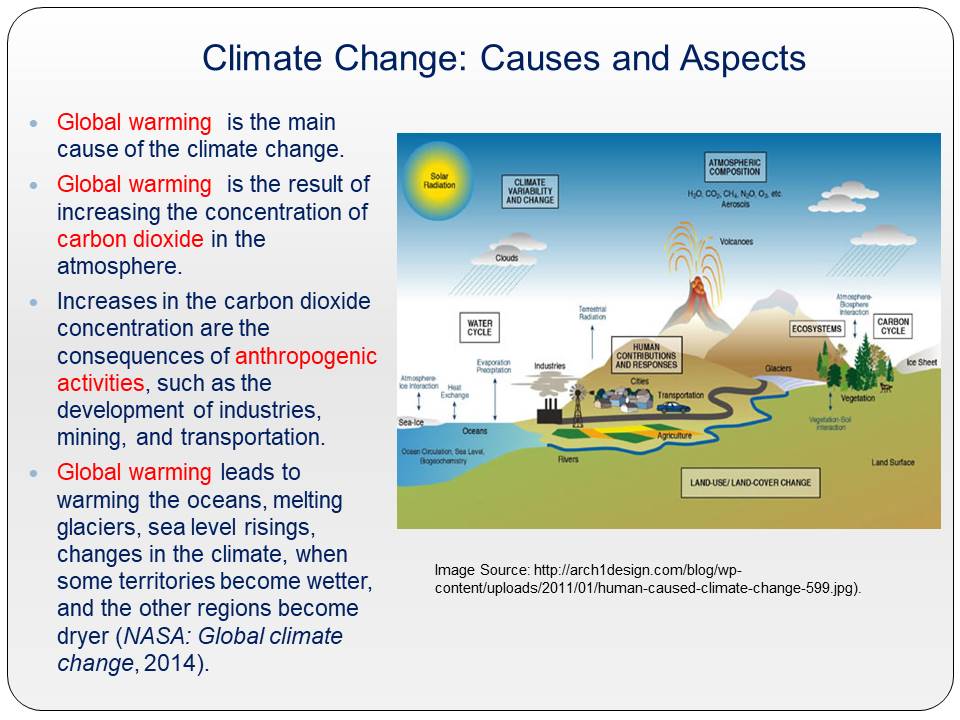
The Problem’s Impact
The population of the whole world is impacted by the problem of the climate change.
Developed Countries (North America, Europe, and Japan):
- The snowpack in mountains will melt;
- The frequency and duration of heat waves will increase;
- The risk of inland and island floods will increase;
- The sea level will rise;
- Frequency of storms will increase;
- Crop productivity will decrease (NASA: Global climate change, 2014).
Underdeveloped Countries (South America, Africa, and Eastern counties):
- The population will suffer from increased water shortage;
- Decreased access to food;
- Increased risks of flooding and droughts (NASA: Global climate change, 2014).
The population of the whole world is impacted by the problem of the climate change. However, the impact on the population of developed and underdeveloped countries can be discussed as rather different, depending on the region.
The population of the developed countries, including the countries of North America, Europe, and Japan, will be affected significantly because the snowpack in mountains will melt; the frequency and duration of heat waves will increase; the risk of inland and island floods will increase; the sea level will rise; frequency of storms will increase; crop productivity will decrease (NASA: Global climate change, 2014).
The population of the underdeveloped countries, including the countries of South America, Africa, and Eastern counties, will suffer from increased water shortage; decreased access to food; increased risks of flooding and droughts (NASA: Global climate change, 2014).
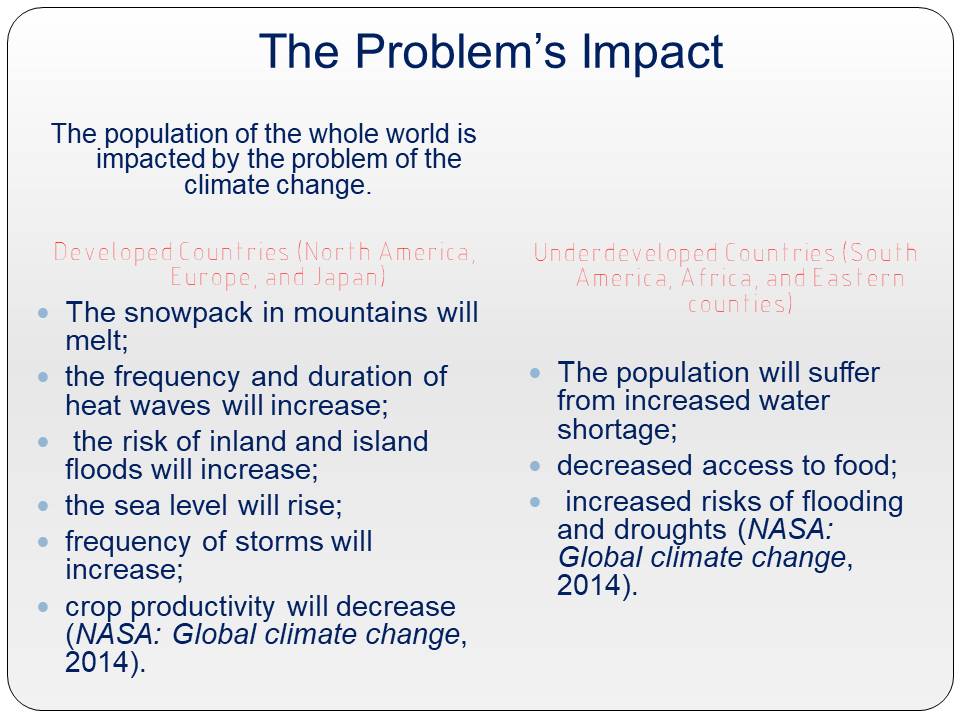
Industrial Ecology and Environmental Chemistry
- Industrial ecology – the climate change is the direct result of the men’s activities.
- The solution – the focus on developing sustainable industries and reducing carbon dioxide emissions (Dessler, 2011, p. 84).
- Environmental chemistry – the climate change is a result of the greenhouse effect and the associated processes in the atmosphere.
- The solution – the change in the approaches to using coal, oil, and gas and the focus on biofuels (McNall, 2011, p. 111).
Two science disciplines used to frame the problem of the climate change are industrial ecology and environmental chemistry.
Industrial ecology is selected because the climate change is discussed in this field of knowledge as the direct result of the men’s activities. Thus, one solution to resolve the problem is to focus on developing sustainable industries and reducing carbon dioxide emissions (Dessler, 2011, p. 84).
Environmental chemistry discusses the climate change as a result of the greenhouse effect and the associated processes in the atmosphere. The first step to resolve the problem is to change the approaches to using coal, oil, and gas and focus on biofuels (McNall, 2011, p. 111).
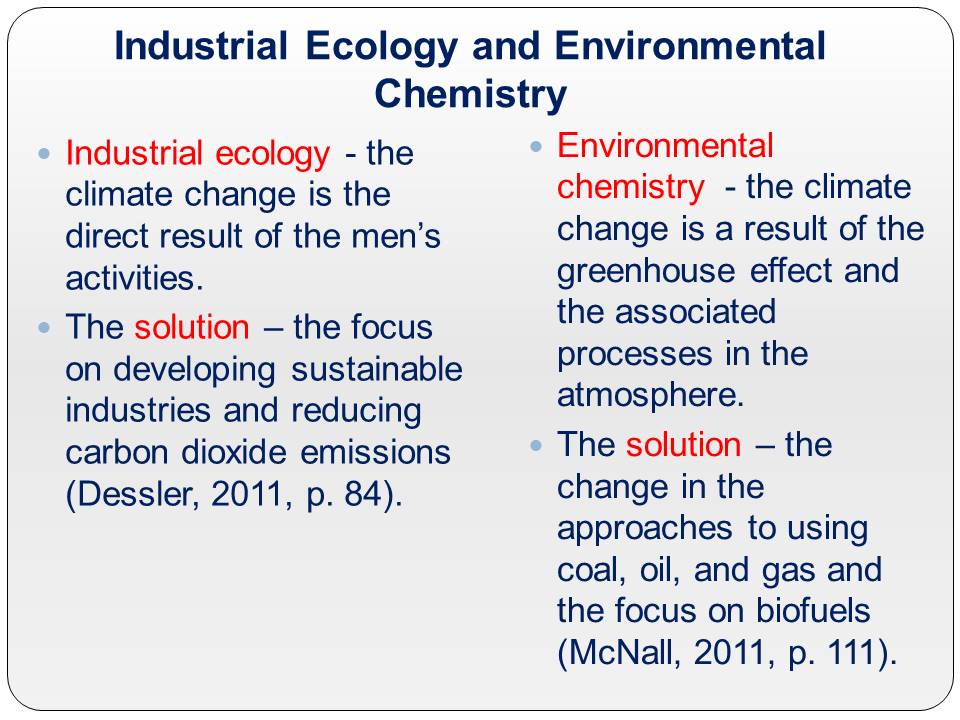
Solutions Proposed by Disciplines
- Industrial Ecology – scientists propose the effective way to decrease the global warming effects with references to the idea of sustainability.
- Environmental Chemistry – it is more reasonable to find the alternative ways of energy and focus on biofuels.
- The focus on the idea of suitability is characteristic for both the approaches.
The approach used with references to industrial ecology contributes to resolving the problem of the climate change significantly because the scientists propose the effective way to decrease the global warming effects with references to the idea of sustainability.
Environmental chemistry proposes the approach according to which it is more reasonable to find the alternative ways of energy and focus on biofuels.
The focus on the idea of suitability is characteristic for both the approaches.
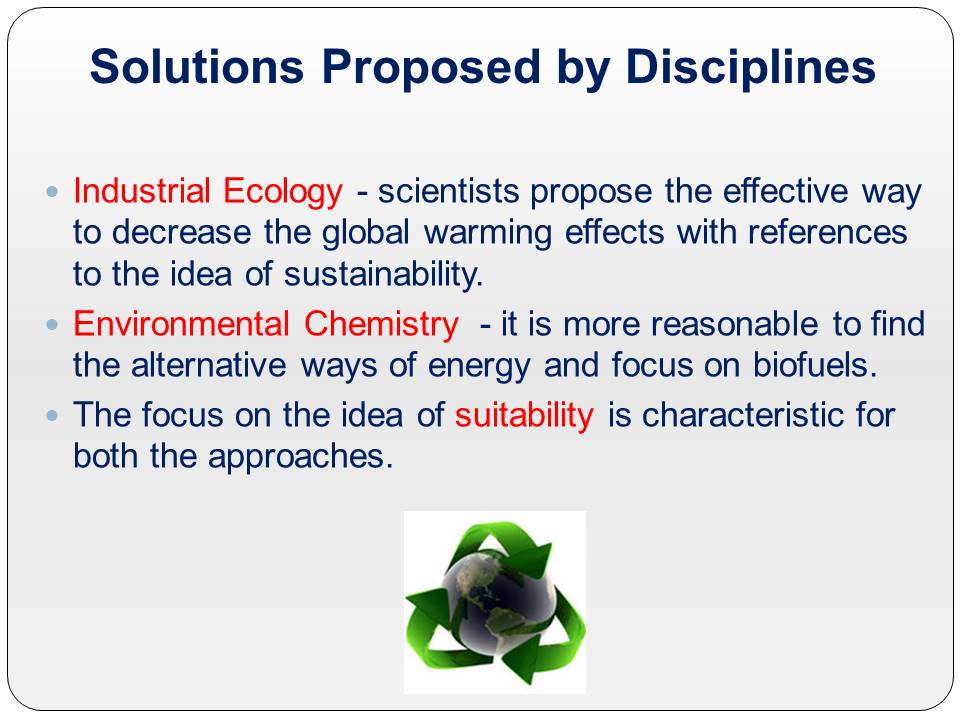
Possible Solutions to Resolve the Climate Change Problem
Possible solutions to the problem of the climate change are the following ones:
- The practical focus on using the alternative renewable sources of energy.
- The focus on sustainable development as associated with management, governments’ policies, and environmental standards.
Possible solutions to the problem of the climate change are the following ones:
The practical focus on using the alternative renewable sources of energy.
The focus on sustainable development as associated with management, governments’ policies, and environmental standards.
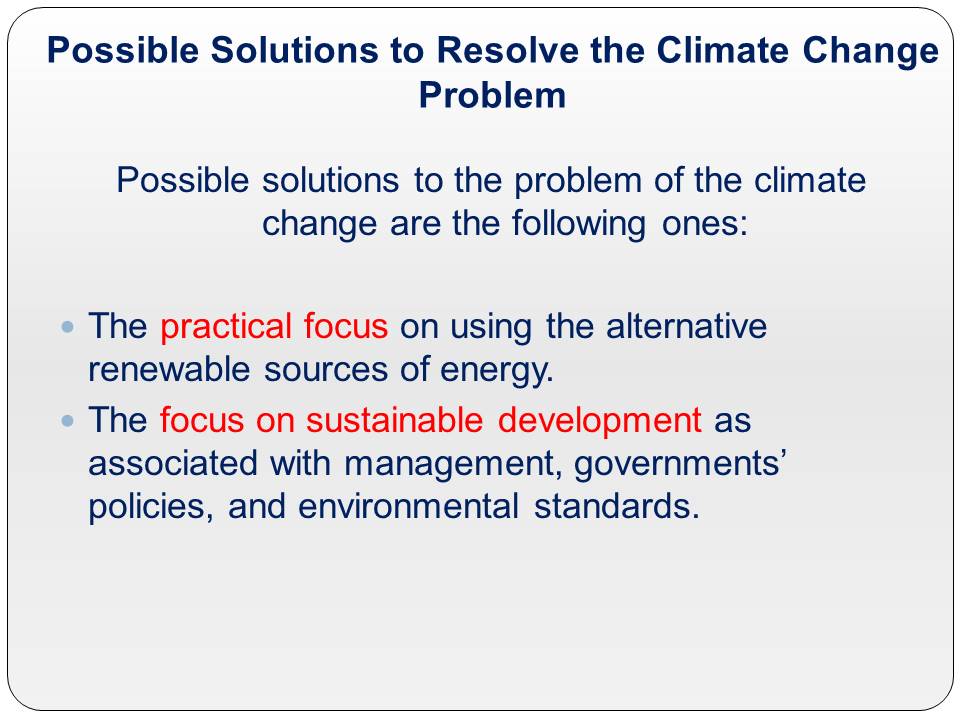
Pros and Cons of the Solutions
First Solution
PROS:
- cost-effective;
- sustainable technologies are the priorities today;
- developed countries promote using alternative sources of energy;
- investment in the industry increases;
- decrease in CO2 emissions is obvious;
- scope for using biofuels is large.
CONS:
- the necessity to implement new innovative technologies;
- increased competition within the industry.
Second Solution
PROS:
- the climate change problem is discussed at the international conferences, and the proposed solutions are implemented at the global level;
- focus on policies and management is effective to control the problem’s development.
CONS:
- high costs associated with implementing new policies;
- the risk of provoking unfair competition within the industry (Dessler, 2011, p. 84; McNall, 2011, p. 111; NASA: Global climate change, 2014).
The pros associated with the first solution and the focus on using the alternative renewable sources of energy are the following ones:
- The use of renewable energy is cost-effective;
- The use of sustainable technologies are the priorities for many industries today;
- Developed countries promote the research in the field and pay more attention to using alternative sources of energy;
- Investment in the industry increases;
- The decrease in CO2 emissions is obvious;
- The scope for using biofuels is large.
The cons are the following ones:
- The necessity to implement new innovative technologies;
- Increased competition within the industry.
The pros associated with the second solution and the focuses on sustainable development are the following ones:
- The global warming and climate change problems are discussed at the international conferences, and the proposed solutions are implemented at the global level;
- The focus on policies and management is effective to control the problem’s development.
The cons are the following ones:
- High costs associated with implementing new policies;
- The risk of provoking unfair competition within the industry (Dessler, 2011, p. 84; McNall, 2011, p. 111; NASA: Global climate change, 2014).
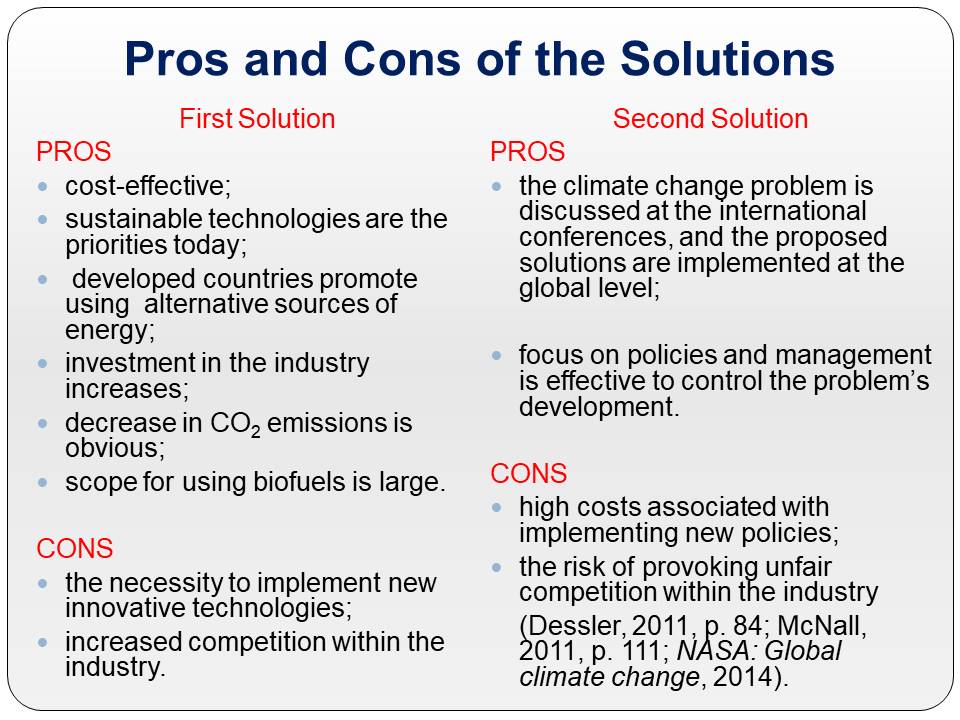
The Best Possible Solution
- The solution to the problem of the climate change can be discussed as effective when the solution is practical.
- The greenhouse effect and the global warming are the main causes of the climate change.
- To reduce the percentage of CO2 emissions in the air, it is necessary to focus on using alternative renewable sources of energy because the use of renewable energy is cost-effective.
- The use of renewable energy contributes to supporting the sustainable environment and proposes such solutions as the use of biofuels.
The solution to the problem of the climate change can be discussed as effective when the solution is practical, and it works to cope with the main cause of the problem. The greenhouse effect and the global warming are the main causes of the climate change. To reduce the percentage of CO2 emissions in the air, it is necessary to focus on developing and using alternative renewable sources of energy in developing and developed countries because the use of renewable energy is cost-effective and attractive for investors, it contributes to supporting the sustainable environment, and proposes such solutions as the use of biofuels.
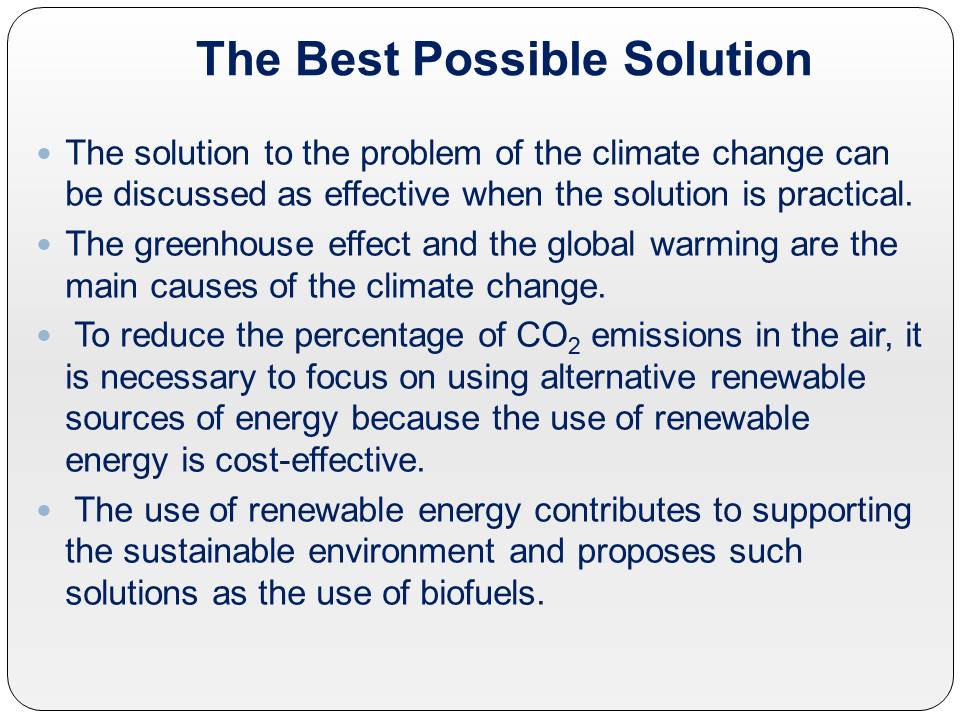
Conclusion
The problem of climate change is extremely significant because it influences all the people living on the planet.
The consequences of the climate change are irreversible, and much attention should be paid to finding the solution which can be effective not only in the economic and policy context but also in relation to its practical usefulness.
That is why, the focus on the renewable energy is the appropriate solution to cope with the problem at the current stage.
The problem of climate change is extremely significant because it influences all the people living on the planet. The consequences of the climate change are irreversible, and much attention should be paid to finding the solution which can be effective not only in the economic and policy context but also in relation to its practical usefulness. That is why, the focus on the renewable energy is the appropriate solution to cope with the problem at the current stage.
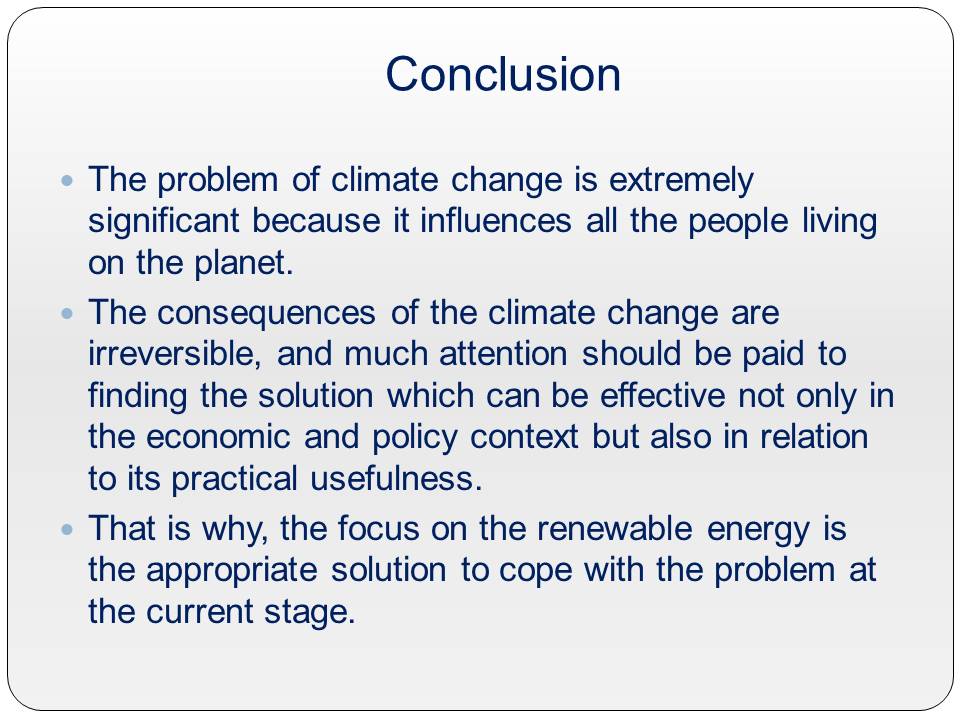
References
Dessler, A. (2011). Introduction to modern climate change. USA: Cambridge University Press.
Lean, J. (2010). Cycles and trends in solar irradiance and climate. WileyInterdisciplinary Reviews: Climate Change, 1(1), 111-122.
McNall, S. (2011). Rapid climate change: Causes, consequences, and solutions. USA: Routledge.
NASA: Global climate change. (2014).